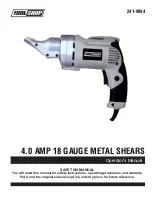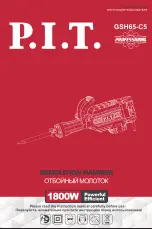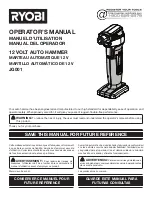
15. USE EYE PROTECTION.
Use a full-face mask if the work you’re doing
produces metal filings, dust or wood chips.
Goggles are acceptable in other
situations.
W
ear a clean dust mask if the work involves creating a lot of fine
or coarse dust.
16. SECURE WORK.
Use clamps or a vise to hold the work. It
’s safer than using
your hands and it frees both hands to operate the tool.
17. DON’T OVERREACH.
Keep proper footing and balance at all times. Do not
reach over or across machines that are running.
18. MAINTAIN TOOLS WITH CARE.
Keep tools sharp and clean for better and
safer performance. Follow instructions for lubricating and changing accessories.
For safe performance, keep handles dr
y
, clean and free from oil and grease.
19. AVOID UNINTENTIONAL STARTING.
Be sure the switch is in the
OFF
posi-
tion before plugging in.
20. ALWAYS CHECK AND MAKE SURE TO REMOVE ANY ADJUSTING KEYS
OR WRENCHES
before turning the tool on. Left attached, these parts can fly
off a moving part and result in personal injury
.
21. DO NOT USE THE TOOL IF IT CANNOT BE SWITCHED ON OR OFF.
Have your tool repaired before using it.
22. DISCONNECT THE PLUG FROM POWER BEFORE MAKING ANY AD
JUSTMENTS.
Changing attachments or accessories can be dangerous if
the tool accidentally starts.
23. STAY ALERT.
W
atch what you are doing & use common sense. Don’t operate
any tool when you are tired.
24. CHECK FOR DAMAGED PARTS.
Before using this tool, any part that is
damaged should be carefully checked to determine that it will operate prop-
erly and perform its intended function. Check for alignment of moving parts,
binding of moving parts, breakage of parts, mountings, and other conditions
that may af
fect its operation. Inspect screws and tighten any ones that are
loose.
Any part that is damaged should be properly repaired or replaced by
an authorized service center unless otherwise indicated elsewhere in the in-
struction manual. Have defective switches replaced by an authorized service
center
. Don’t use the tool if switch does not turn it on and o
ff properly
.
25. REPLACEMENT PARTS.
When servicing, use only identical replacement
parts.
26. SERVICE AND REPAIRS
should be made by qualified repair technicians at
an authorized repair centre. Improperly repaired tools could cause serious
shock or injury
IMPORTANT SAFETY INSTRUCTIONS
SAFETY PRECAUTIONS FOR METAL SHEARS
3
Handle sheet metal with care. Sheet metal will have sharp edges. Wear
ANSI-approved safety goggles, heavyduty work gloves, long sleeve shirt,
and jeans when working with sheet metal.
Maintain labels and nameplates on the tool. These carry important safety
information.
Avoid unintentional starting. Prepare to begin work before turning on the tool.
Do not lay the tool down until it has come to a complete stop. Moving parts can
grab the surface and pull the tool out of your control.
When using a handheld power tool, maintain a firm grip on the tool with both
hands to resist starting torque.
Do not leave the tool unattended when it is plugged into an electrical outlet.
Turn off the tool, and unplug it from its electrical outlet before leaving.
This product is not a toy. Keep it out of reach of children.
People with pacemakers should consult their physician(s) before use.
Electromagnetic fields in close proximity to heart pacemaker could cause
pacemaker interference or pacemaker failure. In addition, people with
1.
2.
3.
4.
5.
6.
7.
8.
-




























